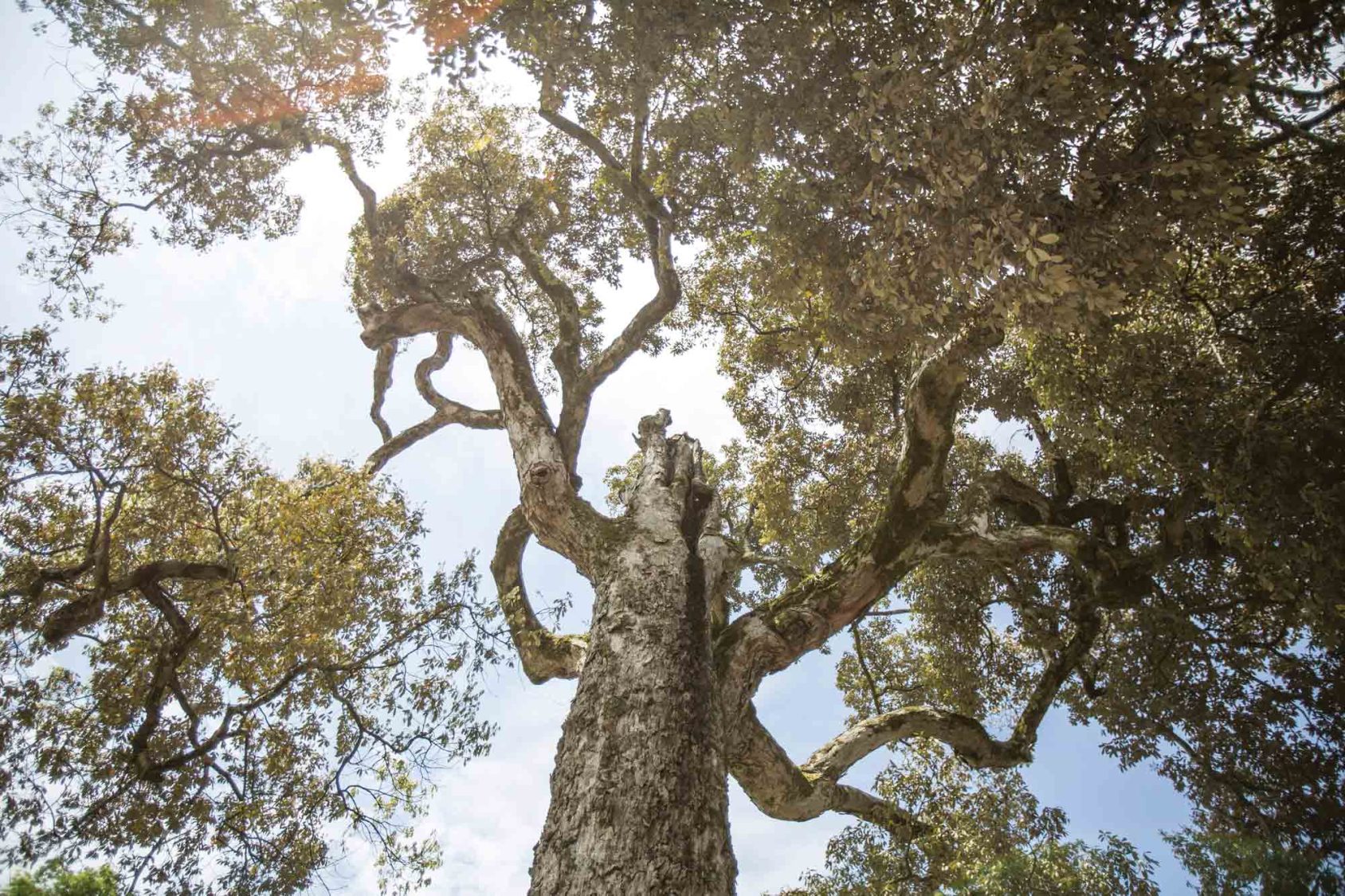The stone wall that runs along the lower boundary of Honen-in temple, on Kyoto’s hilly eastern edge, marks a striking boundary in this ancient center of Buddhist practice. To the right, a jumble of clay-tiled roofs, garden walls, and alleyways falls to the basin where the heart of the city sprawls gray and low. To the left, beyond the wall, a mass of wild camellias, bamboo fronds, oak trees, and pine boughs rises toward the summit of Mount Daimonji. From that green world floats birdsong and crow calls, the smell of new leaves, and the cool, moist air of the mountains. It is hard to imagine a more inviting sanctuary in the city.
I came to Honen-in on an April morning this year to ask its head monk, Shinsho Kajita, about the role his temple plays in preserving Kyoto’s trees. To many Japanese, the question would seem a strange one. It is Shinto shrines, not Buddhist temples, that are viewed as the guardians of wild sacred nature here; their grounds are often wooded, and in recent years they have been recognized as crucial islands of urban biodiversity. Buddhist temples, by contrast, are associated with manicured gardens and zealous gardener-monks who sweep away each leaf the moment it falls. Only occasionally have Japanese monks protested dams or other threats to the forest; for the most part, unlike their counterparts in Thailand and Cambodia, they are not known for environmental activism.
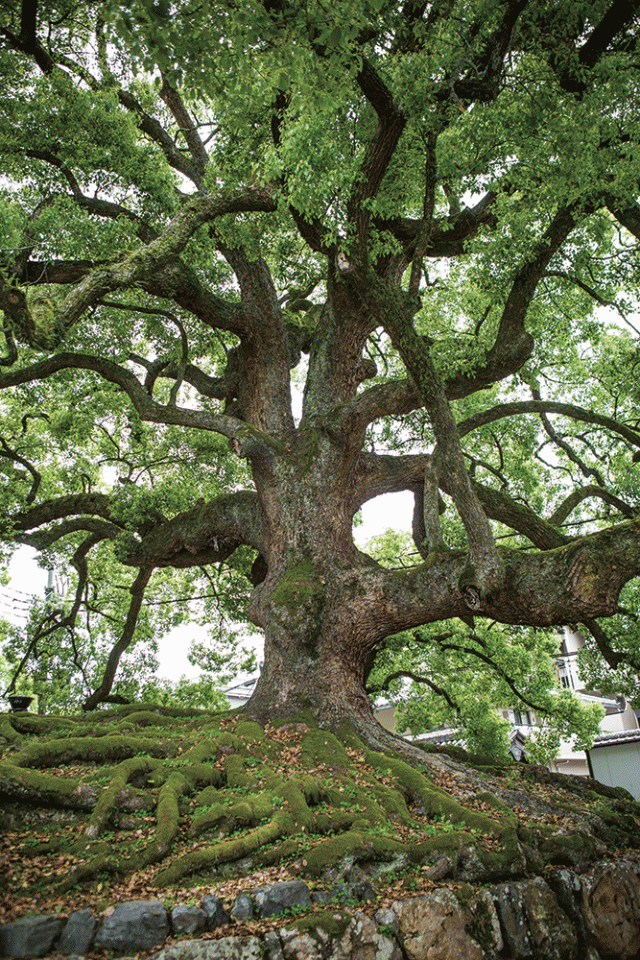
Yet Honen-in sits on 27 acres of deep, dark forest inhabited by badgers, bullfrogs, snow monkeys, and dozens of other creatures. One massive old muku tree beside the main temple is currently the shared living quarters of a ying squirrel, a Ural owl, and a migratory brown hawk-owl; another’s roots shelter a fox den. Honen, the founder of Jodoshu, the Japanese Pure Land school, chose this forest as a site for religious training eight hundred years ago because of the pure spring that flowed beneath its trees. Nearly five centuries later, a temple was built in his memory and the forest claimed as its grounds. It has remained a refuge ever since.
Related: Photos: The Natural Artwork of Japan’s Buddhist Temple Walls
This, at least, was what my companion, Hiroyuki Watanabe, told me as we walked along that lush lower wall and then turned onto a path that cut diagonally inward toward the temple. Watanabe is perhaps the foremost expert on the city’s sacred groves. After spending his career as an ecology professor trekking through the forests of Southeast Asia, he retired and turned his attention homeward. In 2015 he published a book on the forests of Kyoto’s shrines and temples, and today he serves as vice president of Japan’s Society for the Study of Sacred Groves. He says that of the 234 officially recognized large and important trees in Kyoto, 110 are on temple grounds. In other words, Honen-in is far from unique.
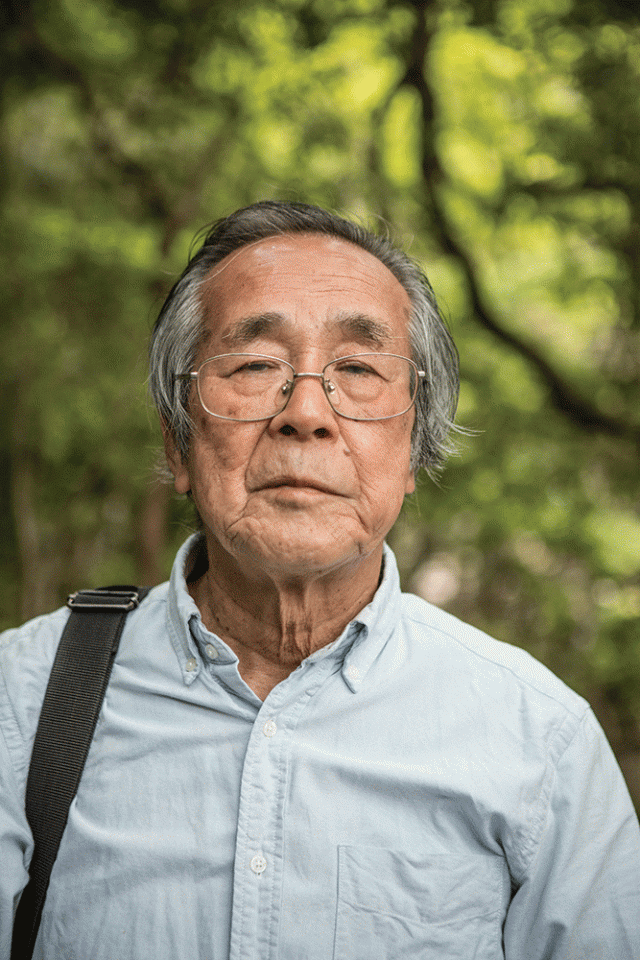
“Buddha, of course, attained enlightenment sitting under a tree, and both Buddhism and Shinto have a long tradition of religious training in forests,” Watanabe had told me the previous morning as we sat in the lobby of my hotel, planning our tour of temple trees. With long wispy hair brushed back from a tanned face and a biker bag slung over one shoulder, he looked younger than his 78 years and as eager as I was for an urban trek. He explained that many temples maintain groves of trees to create a quiet, peaceful atmosphere rather than for explicitly conservationist reasons. Still, they provide the accidental benefit of habitat for birds, insects, and rare old trees hard-pressed by urban development.
The first temple Watanabe took me to, however, contained nothing remotely resembling a sacred grove. Higashi Honganji’s massive prayer halls sit inside a walled compound a few blocks from Kyoto’s main train station, surrounded by a gravel courtyard whose single pine tree looks as formal and forlorn as a kid in a tuxedo. “This is what most Japanese people think of when they think of a temple,” Watanabe told me as we passed through wooden doors high enough to accommodate a giant and into a dim, wax-scented hall. Looking down at the two-foot-wide floorboards beneath my feet, I was suddenly reminded of the other impact Kyoto’s temples have had on surrounding forests. According to historian Conrad Totman, the construction of monasteries consumed over seven hundred million board feet of old-growth timber during the three centuries following Buddhism’s arrival in Japan around 550 CE. Pressure on Kyoto’s forests eased somewhat in the 9th century as monument-building went out of fashion, but only in the 17th century did extensive regulations emerge that allowed forests to fully recover.
We left Higashi Honganji, and Watanabe led me east toward the leafier Higashiyama district. Eventually, he paused on a shady lane and pointed to a gnarled camphor tree. “This is one of the trees that Shinran planted, or so they say,” he said. The tree stands just outside the walls of Shoren-in temple, its moss-covered roots as green and sinuous as a nest of snakes. Legend has it that the founder of Jodo Shinshu planted it and four others here in the late 12th century, when he was a young student at the temple. Watanabe views this legend skeptically; magnificent as the trees may be, he doubts that they are quite that old. Still, their spiritual aura has done more to protect them over the centuries than their official designation as a natural treasure, awarded more recently by Kyoto’s municipal government. “Those huge roots tell the history of this place,” the elegant elderly woman selling entry tickets inside the gate told us with a smile. “We would never cut them down.”

From Shoren-in we headed northwest to the confluence of the Kamo and Takano Rivers. There, surrounded by clinics, restaurants, and schools, stands a 31-acre primeval forest. This hushed and shadowy world belongs not to a temple but rather to one of Kyoto’s most revered and ancient Shinto shrines: Shimogamo-jinja. Religious prohibitions on cutting wood, hunting, and fishing within its boundaries (and more recently, its designation as a UNESCO world heritage site) have kept it more or less intact for at least two millennia. We stepped inside the entrance to the woods and paused at a signboard with a painted map. High above us, thousands of newly formed leaves rustled in the wind. “Do you see that empty spot?” Watanabe asked, pointing to a corner of the map. “There used to be a temple there.” In fact, although it is hardly mentioned now, the Buddhist Jingu-ji (meaning “shrine temple”) shared Shimogamo’s grounds for a thousand years. The same was true at many shrines throughout Japan; for 13 centuries, the two religions were closely entwined.
“Those huge roots tell the history of this place. We would never cut them down.”
It was only in the late 1800s that Japan’s government forcibly separated them, destroying many temples and establishing Shinto as the state religion. This history is one of the reasons Watanabe believes that temples deserve nearly as much credit for protecting Kyoto’s important trees as shrines do. “We don’t know, because the historical documents to prove it are gone, but it is very likely that the monks helped care for and protect this forest during the period in which the temple existed,” he said.
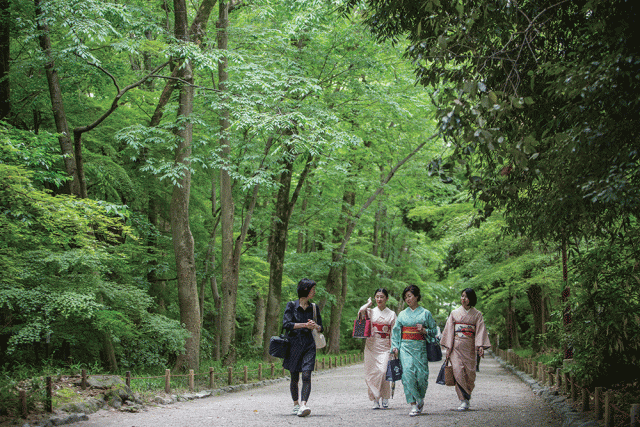
By this time the sun was low, and after a quick stop to see a pair of rare red-bark oaks outside Kinkaju-ji, the tourist-besieged Golden Temple, we called it a day. The next morning, we set out for Honen-in. Skirting a string of verdant temples and shrines lining Daimonji’s base, we made our way to the path that cuts into Honen-in’s grounds, passed through a small but beautifully arranged garden, and arrived at the door of a simple post-and-beam building. This is both the temple’s spiritual center and the headquarters for the Rev. Kajita’s many cultural and environmental endeavors. Ever since Kajita took over the temple from his father in 1984, he has been deeply engaged with the natural and human communities surrounding it. In 1985 he launched a “forest classroom” to hold nature walks and talks on the grounds. That project evolved into a citizen-led forest center that both helps to manage the forest and uses it as an outdoor education center for children.
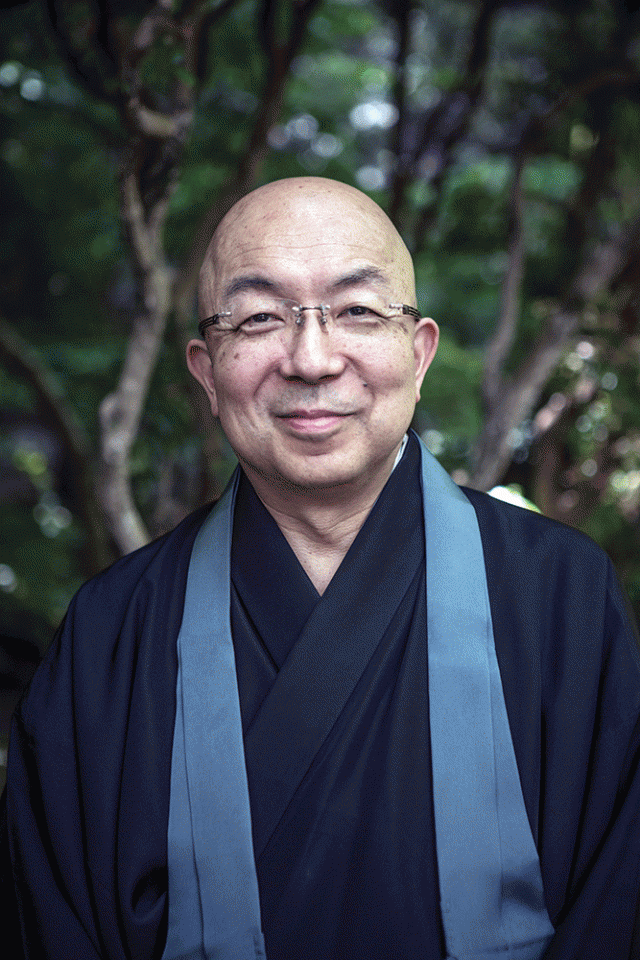
We knocked on the door and were admitted by an assistant who led us to a tatami-floored room and set three cups of tea on the table. A moment later, Kajita pushed open the sliding paper screen. He was wrapped in simple black robes, his most outstanding feature a pair of animated eyebrows that jumped up and down on his round, shaved head as he greeted us. I had come with the intention of finding out about his work to protect urban trees, but the question I found myself even more interested in was how those trees have a affected Kyoto’s Buddhists. As he settled into a low chair, I asked him how he felt toward the forest.
“I think that temples in the woods serve as places for us to become aware that plants and animals and humans are all fellow beings,” he replied. “You’ve probably heard of reincarnation. Long ago, before I was born, I may have been a cherry tree, and when I die, I might become a camellia.” He giggled at this thought. I nearly did too—it’s a possibility I’d never imagined before. A cat, perhaps, or a worm, but a tree? Kajita explained that early Buddhist thought in India generally considered only animals to be fellow beings containing the potential for enlightenment. As the religion traveled northwest to China, however, that concept expanded to include plants. When it arrived in Japan, it layered neatly on top of Shinto, which taught respect and awe for all of creation.
“Temples in the woods serve as places for us to become aware that plants and animals and humans are all fellow beings.”
“Encountering the forest and its creatures every day,” he continued, “I am able to confirm within myself that at some point I may have existed in those forms. It is not just that the cherry trees are beautiful, or the forest calms us. It is that in the end, I have the understanding that we are fellow living beings and the desire that eventually we will reach enlightenment together.”
Related: Why Trees Are The Ultimate Meditation Teachers
We talked for a few more minutes, and then Kajita excused himself for another appointment, giving us permission to wander through the temple on our own. Three camellia trees were blooming in the raked-sand courtyard, and someone had carefully placed their brilliant blossoms everywhere: on the floor of the prayer hall below the gaze of a golden Buddha, floating on the surface of a fluted basin in the garden, gracing the lip of a stone fountain. We continued out to the main garden. There was the muku tree Watanabe had told me about, its thick old trunk sheltering sleeping owls and squirrels (or so I imagined), and there was a Japanese bodhi tree, common in the temples of both Japan and China. From the garden we passed through a thatched gate and down a shaded lane to the temple graveyard. A weeping cherry tree drooped over the stone markers, its profusion of blossoms a silent echo of Kajita’s words.
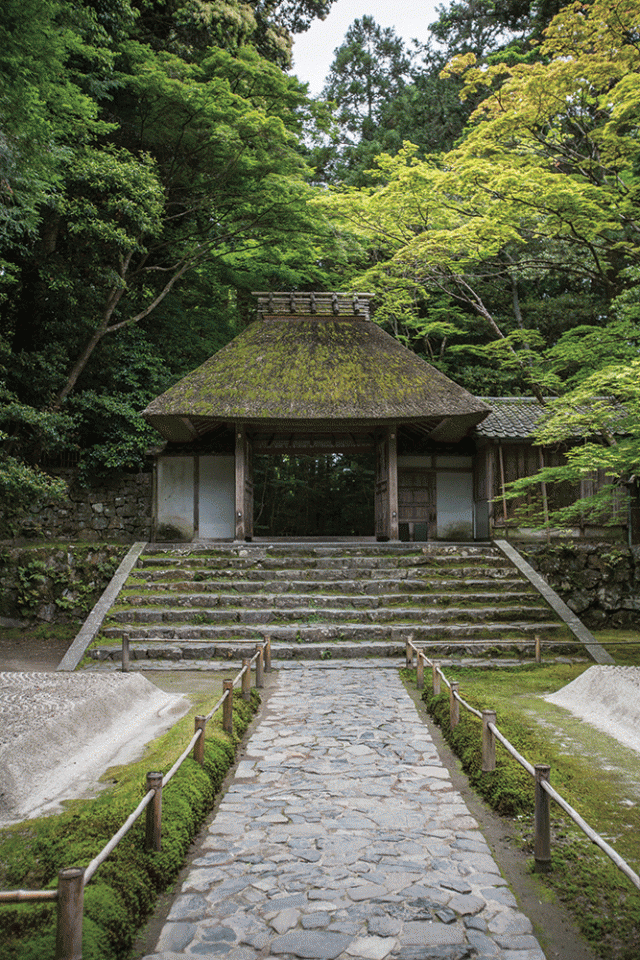
The path continued to the left and then veered steeply into the woods. We followed it quietly, each lost in our own thoughts. I was conscious of being absorbed in the aspects of the forest that Kajita had characterized as surface distractions: its beauty, its calming, cocoon-like quiet. The deeper connection to the trees that he had spoken of still felt abstract. Yet if any city in the world is suited to seeking that connection, it is Kyoto. For that, I now knew, we have 300 years of Buddhist monastic stewardship to thank.
Thank you for subscribing to Tricycle! As a nonprofit, we depend on readers like you to keep Buddhist teachings and practices widely available.
